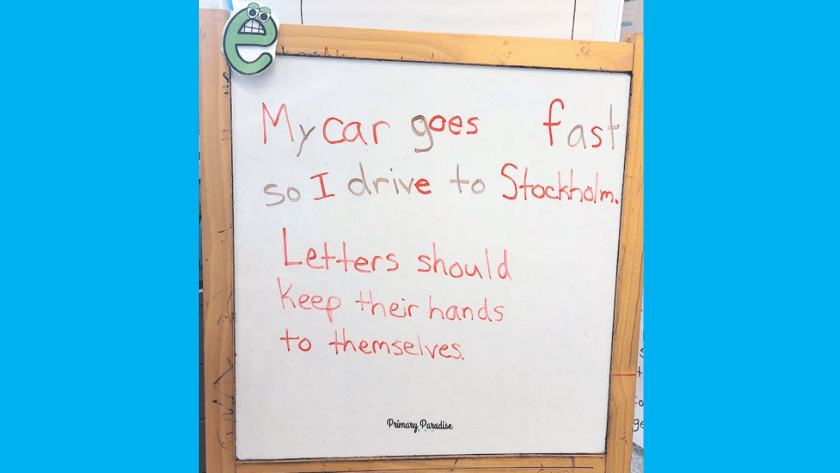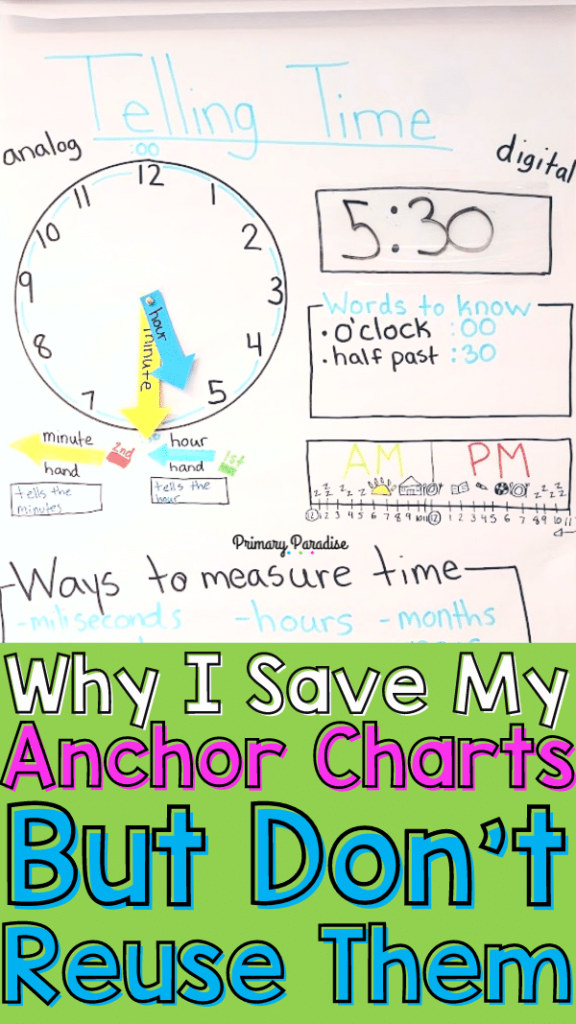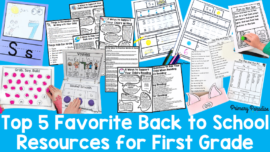Anchor charts are a huge part of teaching and learning because it’s often the quickest and easiest way to document learning, share new information, and collect student ideas. Anchor charts also allow students to look back and recall past information. Anchors serve very specific purposes, and have an important role in lower elementary education. Here is why I always save my anchor charts, but I never reuse them from year to year.
Step away from the laminator
When I first started teaching over 10 years ago, I did what many teachers at the time did. I created posters, sometimes before the school year began. I laminated them, and then pulled them out and showed them to my kids when we learned about a new topic. Although I scoured the internet and spent countless hours creating cute graphics with catchy words to explain how and why and where and when for reading, math, science, writing, I noticed the same thing as the year went on. My students never referred to them. I wish I could say my second year I learned my lesson, but alas it took a bit longer to realize I was completely missing the point of an anchor chart.
What is the point of anchor charts?
The fact that I was laminating these creations and planning to use them year to year was evidence that I had no idea what the point of an anchor chart was. So, what is the point? Anchor charts are touch points, or anchors, if you will, for learning. They should be created in a way that students can refer to them to either recall information or see a learning journey. How I created these posters was the important piece that I was missing.
Anchor charts should be constructed with and by students
The problem with my posters? They were not created with my students. The whole point of anchor charts is to help students understand a concept or recall past learning. So, the only way to do this is to co-construct anchor charts with your students. This obviously looks very different in every grade level and with different classes. In the beginning of the year in grade one, I might do the majority of the writing, but my students’ thoughts and ideas are the backbone of the anchor chart. As the year progresses, we move towards sharing the responsibility of writing.
Anchor charts can evolve over time
Often we will work with an anchor chart over a period of days as a class. I sometimes prepare a structure for an anchor chart before hand. However the majority of the chart is created with students. For example, I might write the title and a box for a definition. I might trace a circle for a clock since I know drawing a clock on the spot might not look very good. Then, as we come up with new understanding and our knowledge on a topic deepens, we will continue to add to it.

Here’s an example of an anchor chart we constructed on telling time. After the first week, it had evolved significantly. However, it still wasn’t done! We had some more learning to add the next week as we explored time to the quarter hour. This is also a great example of how anchor charts can be interactive! The clock hands move, and we can write the digital time with dry erase by adding contact paper (or old laminating scraps) to that section.
Anchor charts are for the students
The other way I was totally missing the mark was that I was creating these posters before I knew my students sometimes. And, I did have their input. Since anchor charts are for the students (not for my aesthetic pleasure) it is vital that they are involved in the creation process. Using kid friendly language is great, but it’s even better when the kid friendly language comes from the kids. After all- it helps them to make meaning when they are asked to explain things in their own words.

A great example of this is when we were creating an anchor chart on what a sentence should include. In our discussion of having spaces between our letters in addition to our words, one of my students said “The letters should to keep their hands to themselves!” which went right on the chart and was a frequent refrain that year. The fact that it came from a kid made it so much more meaningful.
Why Save Them?
You might be wondering, why I save my anchor charts if I don’t reuse them. Although the anchor charts will change from year to year based on my students, I do like to save the previous year’s chart for inspiration. I often look at the final product and decide the structure for the new one. I might jot down some quick notes on a post it for vocabulary or definitions I think should be included. It’s easy to find them because I save them in a container with that unit.
The bottom line is this: anchors are for the students. They should be created together, with student input. And, they should change from year to year to fit your students’ needs.
You might also enjoy:
Three Simple Ways to Get Students Moving While Learning
Why Teachers Need to Be Out of Control
How to Teach Narrative Writing in K and 1st Grade




